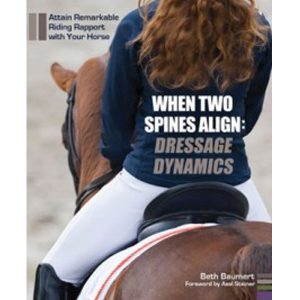Showing the single result

$69.95Read more
When Two Spines Align Dressage Dynamics by Beth Baumert Hardback
Within riding exists a fundamental conflict of interest: The rider needs to have control— confidence depends on ability to control the balance of own body as well as that of a very powerful horse. The horse, by nature, needs to feel free—free in both mind and body to express himself through physical movement.
Readers will discover how to use “positive tension” and what the author calls the four physical “Powerlines”—Vertical, Connecting, Spiraling, and Visual—to become balanced and effective in the saddle. Readers will then find ways to understand and manage the horse’s balance and coordination challenges, including the fact that he is inherently crooked and naturally inclined to do too much with his front end and not enough with his hind.